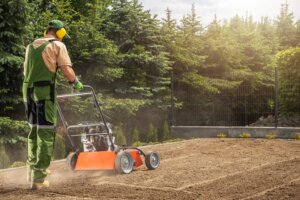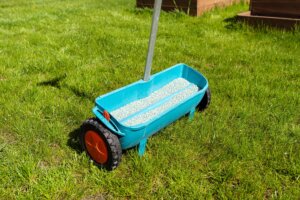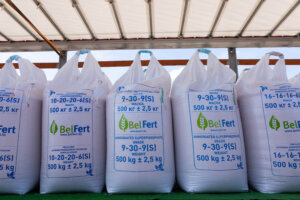Want a lush, vibrant Pennsylvania lawn that thrives all season long? Learn the expert fertilizer tips and timing tricks the pros at Terra Lawn Care use to keep lawns healthy and green year-round.
TL;DR: Fertilizer Application Essentials
- Test Your Soil – Identify nutrient needs, including N-P-K, phosphorus, and micronutrients.
- Pick the Right Fertilizer – Use organic, inorganic, granular, or liquid fertilizer; follow the fertilizer label for application rates.
- Apply Correctly – Focus on the root zone using broadcasting, drop spreaders, foliar feeding, or fertilizer injection.
- Time It Properly – Fertilize cool season grasses in spring/fall, warm season grasses in late spring/early summer; avoid heavy rain or drought.
- Avoid Over-Fertilizing – Excess nitrogen can cause stunted growth, weed growth, and harm plants.
- Follow Best Practices – Use proper irrigation, soil care, and grasscycling to boost healthy growth.
Fertilizer Application: 5 Key Steps
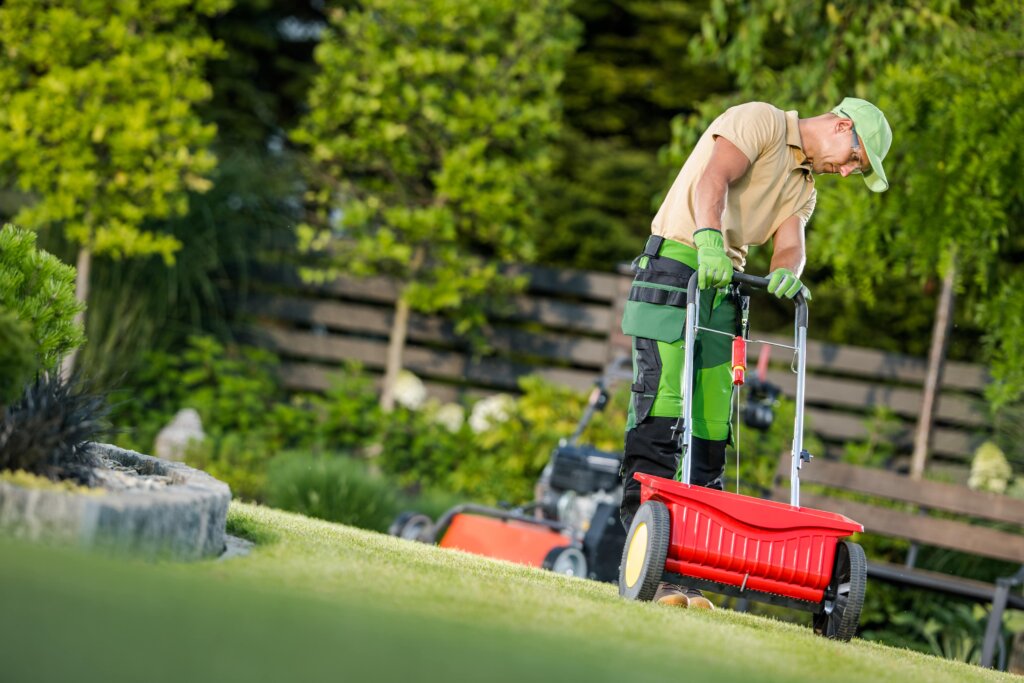
Proper fertilizer application ensures your lawn receives the right nutrients at the correct rate. In fact, according to USDA estimates, as much as 40–80% of applied nitrogen and phosphorus can be lost to the environment if mismanaged.
That’s why knowing the right techniques can make all the difference. Here are five key steps to help you fertilize efficiently and responsibly:
Step 1: Test the Soil
Before applying fertilizer, conduct a soil test to determine nutrient deficiencies and the fertilizer needed. This informs the correct rate of N-P-K, phosphorus, micronutrients, and organic or inorganic fertilizers for your lawn or garden.
Step 2: Choose the Right Fertilizer
Select a fertilizer based on your soil test results and lawn needs. Options include:
- Granular fertilizers / solid fertilizers: Available as slow-release or quick-release; ideal for a steady nutrient supply to plant roots.
- Liquid fertilizer / foliar feeding: Directly applied to leaves for rapid nutrient application, supplementing soil uptake.
Check the fertilizer label and guaranteed analysis to match application rates for nitrogen, phosphorus, potassium, and micronutrients.
Step 3: Apply Fertilizer
| Method | Description |
|---|---|
| Broadcasting | Spread dry fertilizer evenly across the lawn for general coverage; suitable for large areas. |
| Drop Spreader | Provides precision for smaller lawns or borders, reducing fertilizer needed and minimizing runoff. |
| Foliar Feeding | Spray liquid fertilizer directly onto leaves for fast absorption by plant roots. |
| Fertilizer Injection | Used with irrigation water for professional applications, efficiently delivering nutrients directly to the root zone. |
Step 4: Water Your Lawn
After application, irrigate lightly to move solid fertilizers into the soil surface and root zone, enhancing nutrient uptake and minimizing leaching. Avoid overwatering to conserve natural resources. For additional tips, check our blog on Should You Water Your Lawn After Fertilizing?
Step 5: Follow Correct Application Rates
Always apply fertilizer at the correct rate to prevent too much nitrogen, stunted growth, or damage to plants. Use ammonium sulfate, urea ammonium nitrate, or other fertilizers according to fertilizer label instructions, and consider organic matter and lawn type when calculating application rates.
For step-by-step guidance tailored to Pennsylvania lawns, see How to Apply Lawn Fertilizer.
How Much Fertilizer Is Needed?
Your fertilizer application rate depends on:
- Lawn size (in square feet)
- Grass type (cool season vs warm season)
- Soil nutrient levels (soil test results)
- Fertilizer type (slow-release vs fast-release)
Applying too much fertilizer can damage plants, encourage weed growth, and contribute to nutrient leaching. Follow the package label instructions and adjust based on soil health and grass growth. For an in-depth overview, see our article on How to Fertilize Lawn.
Pro Tip: Focus on the root zone, not just the soil surface, for efficient nutrient absorption.
Understanding Fertilizers: Organic vs. Inorganic
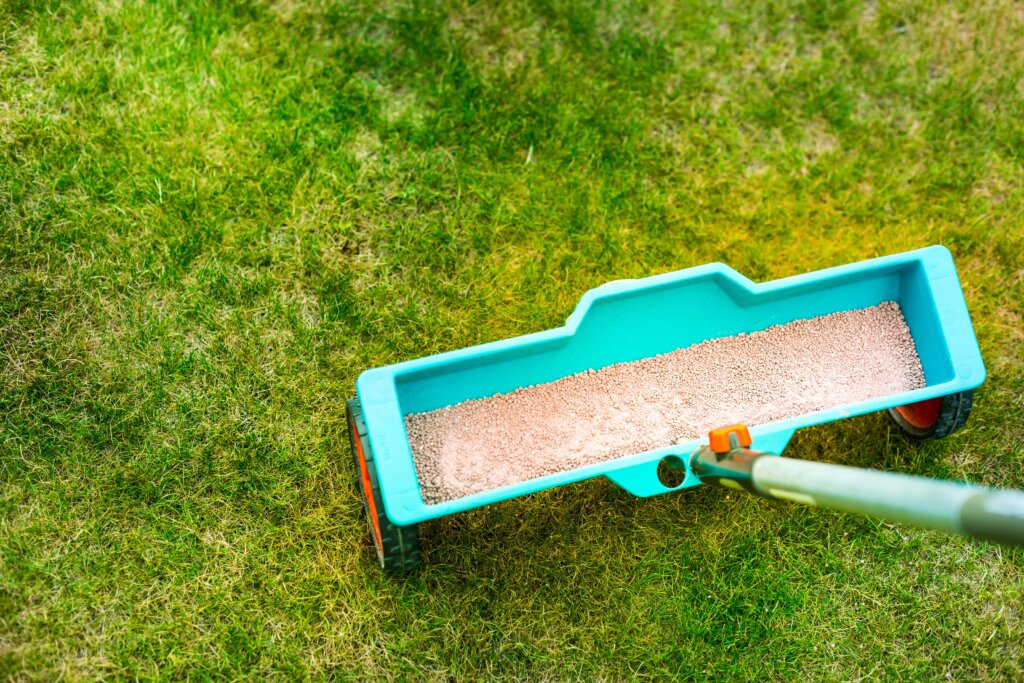
Fertilizers supply essential plant nutrients like nitrogen, phosphorus, and potassium (N-P-K) that support healthy growth, root development, and overall lawn health. Choosing the right type ensures your lawn receives the nutrients it needs without risking too much nitrogen or nutrient leaching.
| Fertilizer Type | Key Features |
|---|---|
| Organic Fertilizers | Made from natural sources like compost, manure, or bone meal; slow-release; improves soil health and adds organic matter. |
| Inorganic Fertilizers | Chemically manufactured (e.g., urea ammonium nitrate, ammonium sulfate); fast-acting; provides immediate nutrients but minimal long-term soil improvement. |
Pro Tip: Always check the fertilizer label and guaranteed analysis to match your lawn’s nutrient requirements. For more guidance on getting it right, see How to Use Fertilizer: A Complete PA Guide.
Fertilizer Types and Nutrient Considerations
- Nitrogen (N): Promotes leaf and root growth, dense turf, and color.
- Phosphorus (P) & Potassium (K): Support root growth, stress resistance, and overall plant health.
- Micronutrients: Calcium, magnesium, and iron support metabolic functions and chlorophyll production.
Use soil tests to correct deficiencies and determine if additional nutrients are needed. Liquid fertilizers and water-soluble fertilizers provide fast results, while solid fertilizers maintain longer-term feeding.
When to Apply Fertilizer in PA

Timing is crucial for effective fertilizer application to ensure nutrients are absorbed efficiently and lawn health is maximized.
Cool Season Grasses
For Kentucky bluegrass, perennial ryegrass, and tall fescue, the best time to fertilize is early spring and fall when growth is most active.
Warm Season Grasses
For Bermuda and zoysia, apply fertilizer in late spring to early summer during their peak growth period.
Factors Affecting Timing
Several factors influence fertilizer timing, including soil type (clay soils vs. sandy soils), rainfall, irrigation, and existing grass health. Avoid fertilizer blackout dates during heavy rain or drought to prevent nutrient runoff and water pollution.
Grasscycling Considerations
Grass clippings can naturally supply nitrogen, so avoid fertilizing immediately after mowing if practicing grasscycling, helping reduce excess fertilizer use.
Avoiding Common Fertilizer Mistakes
Applying fertilizer incorrectly can harm your lawn, waste nutrients, and increase the risk of water pollution. Use this table to quickly identify common errors and how to prevent them:
| Mistake | Impact | How to Avoid |
|---|---|---|
| Over-fertilizing | Leaf burn, stunted growth, nutrient runoff | Fertilize during the growing season based on grass type |
| Wrong timing | Nutrients not absorbed | Fertilize during growing season based on grass type |
| Poor fertilizer type | Inefficient nutrient application | Match fertilizer to soil nutrient deficiencies and fertilizer type (organic or inorganic) |
| Neglecting irrigation | Dry fertilizer can harm grass | Water according to instructions, especially for dry fertilizer |
Using the correct application rates, fertilizer type, and timing ensures healthy growth, protects soil health, and reduces the risk of water pollution. Learn more about professional solutions for balanced lawn nutrition at Terra Lawn Care’s lawn fertilization services.
Local Lawn Care Expertise in PA
Terra Lawn Care is locally owned and family operated, serving the Tri-State area since 2003. Our certified team, guided by an in-house agronomist, ensures safe and effective fertilizer application for your lawn.
We customize nutrient application based on soil test results and grass type for established lawns or new plantings. Learn more about our services and contact us for a consultation.
Frequently Asked Questions About Fertilizer Application
Fertilizer should be applied evenly across your lawn or garden to ensure plants get the nutrients they need. For granular fertilizers, use a spreader to distribute them uniformly at the recommended fertilizer application rate. For liquid fertilizers, you can apply them directly to the leaves or soil for quick absorption. Always check the fertilizer label and make adjustments based on soil test results to apply nitrogen and other essential nutrients like phosphorus
It is best to avoid fertilizing just before heavy rain, as nutrients like nitrogen and phosphorus can wash away, harming plants and contributing to water pollution. Light irrigation after applying granular fertilizers helps nutrients soak into the root zone. For heavy rain, wait until the soil is absorbent to ensure that fertilizing is effective.
The most common methods include:
1. Broadcasting – spreading granular fertilizers evenly over a lawn or garden.
2. Drop Spreader – precise application for smaller areas, reducing waste.
3. Foliar Feeding – spraying liquid fertilizer directly onto leaves for fast nutrient uptake.
4. Fertilizer Injection – delivering nutrients through irrigation systems for professional applications or larger crops.
Choosing the right method depends on your plants, fertilizer type, and lawn or garden size to maximize fertilizer use efficiency.
Avoid fertilizing plants that are dormant, newly seeded, or stressed by drought, disease, or pests, as this can harm their growth. Also, some vegetables and garden crops are sensitive to excess nitrogen, so always follow the fertilizer label and soil test results to apply only what is necessary. Using the correct application rates helps prevent stunted growth and ensures healthy growth for your crops and lawn.

